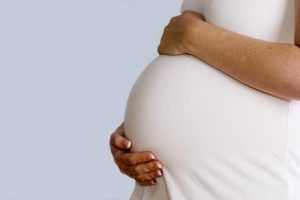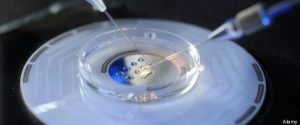
New medical advancements might offer some women a second chance at becoming pregnant. Some women reach menopause much earlier in life, and are unable to become pregnant. Around 1 per cent of women suffer from a condition called primary ovarian insufficiency which brings on menopause at a very young age. Scientists have found a way to wake up dormant follicles, and the experimental technique has been tested on a group of infertile woman who reached menopause at around 3o years old.
Of the 13 women treated, one has given birth, and another is pregnant. There are overwhelmingly high numbers, but it sure proves that there are possibilities and with more research, numbers within trials could rise.
Until now the only option available to women with this form of infertility has been to accept IVF treatment using donor eggs, which means raising a child with another biological mother.
The researchers now plan to see if the technique can help other categories of women, including those affected by cancer treatment, and who become infertile between the ages of 40 to 45.
To read more, click here.

Freezing eggs was always presented as a last option to women but now it’s quickly becoming a perfectly normal procedure that is being encouraged by many. Imagine being your own egg donor when you are ready to conceive. With women postponing becoming mothers, this might just be the right option for some. But the longer a woman waits to undergo IVF, which is the procedure used, the smaller the chances are of becoming pregnant. Those figures do not change. Scientists are now taking it a step further and researching how to screen eggs for chromosomal normality to better achieve successful pregnancies.
In 2006, a landmark trial at NYU Langone Medical Center found that frozen eggs could be used to achieve the same pregnancy rates as fresh eggs, used for in vitro fertilization, using egg and sperm to create an embryo in a lab that is then transferred into a woman’s uterus for pregnancy. “So all of a sudden now, it became an option,” says Jamie Grifo, lead author of the study and program director of the NYU Fertility Center. His team is now researching how to screen eggs for chromosomal normality to better achieve successful pregnancies.
Whether using fresh or frozen eggs, both procedures use IVF, which requires hormone injections that enable a woman to produce multiple eggs each month, which are extracted for fertilization. Frozen eggs require a process called intracytoplasmic sperm injection, in which a single sperm is injected into the egg.
The success rates of producing a baby from one round of IVF is about 60 percent at age 30, 27 percent at age 40 and drops to 6 percent between ages 40 and 44, says Grifo, attributing the declining success rates to the fact that a woman’s eggs develop abnormalities with age. And therein lies the hope of this new technology. “Egg freezing is a way to be your own egg donor,” Grifo says.
As to the cost of the process, the procedure plus doctor’s visits, medication and egg storage can run from $5,000 to $20,000, depending on the lab and the medical practice.
Source
A new type of tourism is emerging and it may surprise you. Apparently, according to research in Europe, egg donation is now one of the leading reasons why couples travel abroad. Couples are traveling to purchase eggs for fertility purposes. Some interesting statistics and figures of who the donors are and where they are from are detailed below.

European Society of Human Reproduction and Embryology (ESHRE) which surveyed 1,423 egg donors at 60 clinics in 11 European countries, has found that the majority of the donors are keen to help infertile couples for altruistic reasons, but a large proportion also do it for money.
The study found a significant effect of age on altruistic motives : 46% of the donors under 25 said altruism alone as their motive compared to 79% of those over 35; 12% of those under 25 were purely financially motivated compared to 1% of those older than 35.
Among the donor groups identified in the study population were students (18% in Spain, 16% Finland, 13% Czech Republic), unemployed (24% in Spain, 22% Ukraine, 17% Greece), fully employed (75% in Belgium, 70% Poland, 28% Spain) and single women (50% in Spain and Portugal, 30% Greece). – Original source found here.
 California is set to change their laws with regards to woman and egg donation. The new bill that is set to pass would allow payments over and above direct expenses to be made to women who donate eggs for research. Law makers are urging the passing of the bill to increase the supply of eggs to scientists studying reproduction. The bill will not eliminate restrictions on research supported by the CIRM, a major funder of stem-cell research. In 2004, California enacted Proposition 71, a referendum that only allowed woman donating eggs to California Institute of Regenerative Medicine (CIRM) researchers to be compensated for direct expenses. A separate 2006 law extended that restriction to all research in California.
California is set to change their laws with regards to woman and egg donation. The new bill that is set to pass would allow payments over and above direct expenses to be made to women who donate eggs for research. Law makers are urging the passing of the bill to increase the supply of eggs to scientists studying reproduction. The bill will not eliminate restrictions on research supported by the CIRM, a major funder of stem-cell research. In 2004, California enacted Proposition 71, a referendum that only allowed woman donating eggs to California Institute of Regenerative Medicine (CIRM) researchers to be compensated for direct expenses. A separate 2006 law extended that restriction to all research in California.
The bill which is expected to pass as early as tomorrow, could bump up payments to women donating from hundreds to thousands of dollars. A recent egg donation study in Oregon offered between $3,000-$7,000 to each woman donating. The pay boost will likely help researchers to compete with fertility clinics for eggs.
More on this can be found here.
Insoo Hyun, a bioethicist at Case Western Reserve University in Cleveland, Ohio, notes that the new bill mandates oversight by institutional review boards (IRBs), which routinely consider whether compensation constitutes “undue inducement” to the point at which participants ignore risks.
But Hyun takes exception to a loophole in the new bill that applies to eggs left over from donors who are compensated for providing eggs to infertile women. According to Hyun, it is a largely unregulated transaction that can fetch more than $10,000 per collection. Under current law, these leftover eggs cannot be used for research. The proposed bill would allow researchers to use them, but also instructs IRBs to ignore how much women were paid for such eggs, provided certain conditions are met, such as the donor deciding she does not need the eggs herself. “The threat of undue financial inducement is one of the key ethical issues in egg donation for stem-cell and other biomedical research,” explains Hyun, “This bill requires the IRB to disregard this. That’s pretty strong language.”









